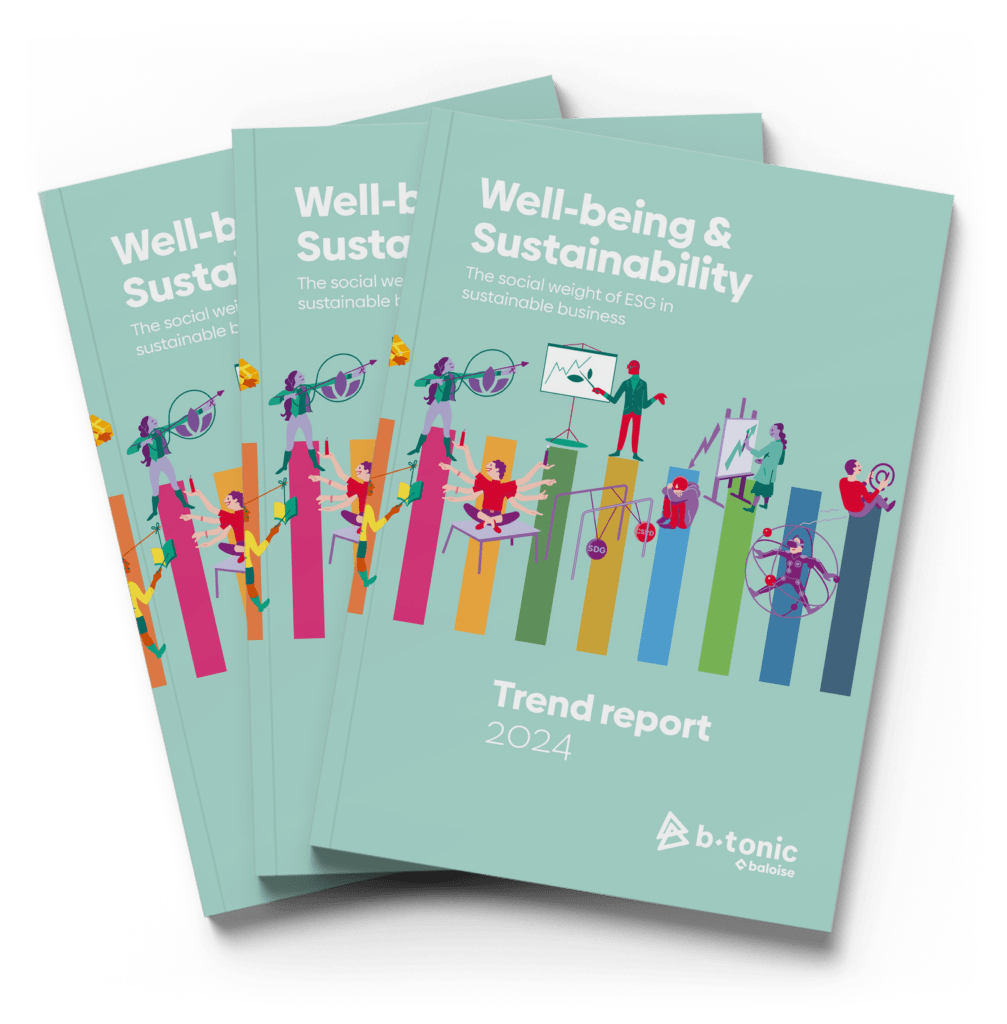Home » Sustainable Development Goals » Sustainable Development Goals – Page 2
Sustainable Development Goals – Page 2
The SDGs lead the way
Content:
Profit, well-being, prosperity
We focus on five SDGs that have a major impact on the well-being of employees on companies and organisations. A sustainable well-being policy is after all the driving factor behind a higher involvement between the various stakeholders, entrepreneurs, management and employees. Putting the human being centre stage is crucial to the sustainable health of economy, society and environment. And by extension for the company and organisation as well. People stay active and productive for longer when they feel good in their role and at work. When personal aspirations, competencies and values match with the work content, organisation and work environment, employees feel like they are doing meaningful work and they are contributing to the bigger picture. The same goes for working for longer – after all a must in an ageing society and in a world where talent is increasingly scarce – which is mostly a matter of working more sustainably, of balance. In order to make sure that employees do not fall off the wagon because of health problems, stress or burnout, we need a broader perspective on working. Success does not stem from a ‘technical’ approach with (risk) analyses , procedures, training courses and administration, but from a broader approach putting the human being centre stage. Deploying employees in accordance to their qualities, talents and skills, with sufficient self-development opportunities, while taking their personal needs and aspirations into account, is the key to success. Organisations that ignore the bigger picture and limit themselves to the legal aspects and procedures, risk higher loss of personnel, more turnover and underperformance. But employees who do not invest in their own development, does not make decisions and snuggle up in a (work) situation that is not actually right for them, risks being railroaded mentally or physically sooner or later. ‘There is no miracle solution to keep employees productive and engaged’ Naturally there is no miracle solution to keep employees productive and engaged. Each employee, each company, each working environment is different. Custom work tailored to human beings and agility of both the individual as the organisations are the takeaways.‘War for well-being’
Sustainable entrepreneurship has become an important lament of employees searching for meaning in their professional aspirations. In the context of the current ‘war for talent’ sustainability is a critical value for your company or organisation. And sustainable means among others an eye for your employees’ well-being. And just like that, well-being has become a powerful weapon in the war for an attractive employer brand. Both to attract new talent and to keep current employees. Not in the least towards the younger generation(s) who choose for employers who are preoccupied with the feelings of their employees. Recent research by consultant Deloitte [5] shows that even 68% of employees and 81% of C-suite (top management) prefer an improved well-being to climbing the corporate ladder. In other words, behind the front line of the current ‘war for talent’ a true ‘war for well-being’ rages on. Besides, a good employee well-being can make your company or organisation more appealing to clients and investors.[5] Deloitte Employer and C-suite well-being survey, 2022: https://www2.deloitte.com/us/en/insights/topics/leadership/employee-wellness-in-the-corporate-workplace.html
In summary: people want to work for organisations where employees lead a happy life. The Deloitte research shows that 59% of employees seriously consider working for a company with better working conditions than their current employer. This evolution is confirmed by research by Randstad [6], showing that 56% of employees between 18 and 24 years old would quit a job that stops them from enjoying their lives; 38% of employees between 55 and 67 years old agree with that.
[6] Randstad, ‘Workmonitor 2022, the#howweworkrevolution’: https://workforceinsights.randstad.com/download-workmonitor-2022
Well-being is thus (much!) more than a strategy of words and a small gesture now and then. It’s a value you promote as an organisation and apply every day. And that value must lead to which the American entrepreneur and founder of Automattic Matt Mullenweg calls: “When everyone in the company has time for their well-being and mental health, when people do their best and use the highest level of their creativity to achieve the best work of their career and simply have fun.” [7] No matter how impossible that nirvana seems to be, experience teaches us that striving towards it is just as stimulating and constructive. For employee well-being and for the organisation.
‘Well-being is (much!) more than a strategy of words and a small gesture every now and then.’
Measuring is the lever
How do you know whether your company culture actually supports well-being? The word on the street (or office hallways) or the posts on HR sites such as Glassdoor and Vault Platform are often subjective information coloured by recent situations at work or the mood of the day. Isn’t it a better idea to measure well-being objectively and communicate the results transparently? This may seem radical, but it is absolutely in line with the ESG reporting, for which companies publicly report their achievements in terms of environment, social policy and good governance. That transparency is so valuable for all involved parties that Europe requires the more and more companies to report on non-financial achievements. That’s reason enough to understand the well-being of your employees better and to communicate about it with the stakeholders.
Obligatory CSRD reporting increases pressure
In a column in MITSloan Management Review Andrew Winston [8] highlights the increasing importance financial markets and investors attach to sustainability. Those are important actors that make capital provision dependent on the sustainability capacity of their client companies. The pressure to start with sustainable entrepreneurship – and thus aligning the business model and company culture with the SDGs – stems, as mentioned above, from all sections in society. Not in the least from the political corner.
For instance, in June 2022 the European Council and European Parliament reached a (preliminary) political agreement on the Corporate Sustainability Reporting Directive (CSRD). This new directive requires a large group of enterprises (250 or more employees) to report on the impact their company has on people and the environment from 2026 on. This information must be verified by an accountant.
This new directive is an expansion of an already existing directive on non-financial reporting (Non-Financial Reporting Directive or NFRD). This 2014 NFRD requires large listed companies, banks and insurance companies to publish non-financial information (a sustainability report) and currently applies to around 12.000 organisations active within the EU region. It requires companies to not only report on, for example, their CO2 emissions and social capital but also on their impact on biodiversity and (violations of) human rights in their value chain.
The new CSRD directive broadens the scope of companies that need to publish a sustainability report. It thus applies to a much larger number of companies – a rough estimate would be about 50.000 in our country – active in all sectors.
Meticulously monitoring your SDG achievements will thus be at least as important as the follow-up of your financial achievements. How do you handle this in the best way possible? The CSRD provides a guideline to harmonise that non-financial reporting, so the information is relevant, comparable, reliable and easily accessible for everyone. At the same time, transparent reporting gives you a basis to measure and report on your achievements and aspirations when it comes to sustainability effectively and consistently. Last but not least, it provides investors or other business partners accurate information that they in turn can use to substantiate their decisions. Finally, it reduces the risk of greenwashing [9].
Do realise that companies that don’t need to report yet, will experience pressure of their stakeholders to start reporting sooner. We call this the trickle-down effect or pressure of clients, employees, suppliers, … that consider sustainable entrepreneurship to be crucial to sustainable value creation. This way, SDG compliance will be the catalyst of employer branding and reputation management.
Top 5 SDGs with direct impact on well-being The indicators based upon which you can monitor the execution of the SDGs, are principally meant for...
How to build a well-being culture? The World Health Organization defines health as the sum of an ultimate physical, mental and social well-being. That inherently...
CSRD – Who needs to report when? The application fo the CSRD happens in three phases. The scale of your company determines in which phase...
Good life goals translate SDGs into everyone’s life The Good life goals focus on the individual to achieve the ambitions of the SDGs. In the...
What are the Good work goals? The Good work goals aspire to a working environment that is safer, healthier, more resilient, more inclusive, happier, more...
‘Those who offer solutions will be the winners’ Siviglia Berto, Managing Director of B-Tonic, explains why the SDGs are so important for B-Tonic’s ‘why’ and...









